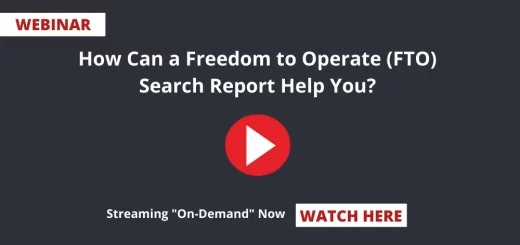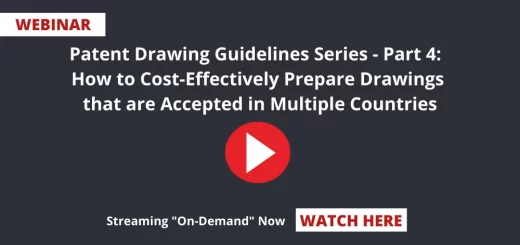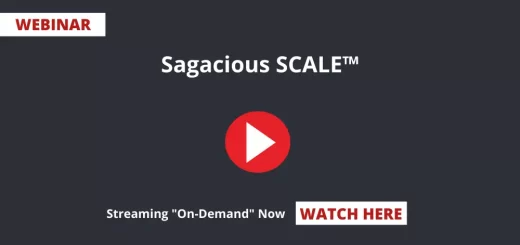Paid and Free Patent Databases – Webinar
Table of Contents
Webinar Topic: Does Searching on More Than One (Paid + Free) Patent Databases Mean Better Search Quality?
Searching patents on a patent database is an art and one must know how to effectively search patents using technical keywords, various operators & prior experience. Although all these databases have the same public patent information however there is difference in backend methodologies around data processing, management of corporate trees, accurate translations of foreign language patents and many. There are many such important questions that this webinar can help us analyse and make a wise decision.
Key Points to be Covered in the Webinar:
- Worldwide coverage – How many countries actually gets covered in it?
- Language coverage – How efficiently various language keywords work?
- Legal Status Accuracy – Can we rely on the legal status available on these databases?
- Assignee Corporate Tree – Do they have an updated assignee corporate tree?
- Which database works better for us and which one not?
Key-note Speakers:
Rohit Joshi, Manager at Sagacious IP
Anchor:
Tanmay Mittal, IP Head at Sagacious IP
Submit Your Information to watch the Webinar Video:
"*" indicates required fields
Webinar Transcript
Tanmay Mittal: Hi, everyone. I would like to acknowledge all of you for joining on time. We are scheduled to begin in another two minutes. So, let us wait for more people to join us. To utilize this time, let me walk you all through the tech checks, and the systems.
By default, all participants are in listen only mode. You can easily find the microphone icon on the control panel. Once the speaker finishes his talk, you can unmute and ask your questions. I hope I am audible and my screen is visible to all. For a better experience, we recommend using headphones or earphones. We shall begin the webinar in just a moment, so I suggest we all make ourselves comfortable and be prepared for the journey.
Tanmay: A warm welcome to all our listeners. I see that we have people joining us from various countries for this webinar today. At the onset, I want to say that I hope you all are doing well during these testing times. Please accept our best wishes for you and your loved ones.
This is Tanmay Mittal, the head of IT solutions, India region at Sagacious. Signing in from Delhi, India to welcome you all.
Over the past weeks, we shared a few polls on LinkedIn to understand how IP professionals around the globe ensure accuracy and exhaustiveness while searching prior arts. The results of these polls were quite interesting, and, hence, we decided to host this webinar today. We intend to share two findings and disseminate best practices related to searching prior arts today.
Before I go on and introduce the keynote speaker for today’s session, I want to express my gratitude towards all our listeners who took out the time to be a part of this session. Your participation is a wonderful encouragement to the efforts and attempt that we’re making to raise awareness about intellectual property through the knowledge that has been honed by us, over several years of working with inventors, R&D organizations, IP departments, and IP law practices.
We are one of the largest IP solutions provided globally, helping organizations monetize, defend, and expand their IP portfolios. Please feel free to read more about us on our website or on LinkedIn.
Joining us today is Mr. Rohit Joshi. Rohit holds a Bachelor’s of Engineering Degree in mechanicals from the Delhi College of Engineering. He has been adding value to the IT industry for quite some time now.
Rohit has a knack for identifying prior arts and he leads a team of equally dynamic and tech savvy IT professionals of the Mechanical Engineering team at Sagacious IP. Rohit has at many instances, provided spot on relevant results during FTO and invalidity opinions for many of our esteemed clients globally.
Welcome to the webinar, Rohit. It is a pleasure to have you with us today.
Rohit Joshi: Thank you, Tanmay. Looking forward for the webinar.
Tanmay: Great.
Before we move ahead, I invite our listeners to keep sharing their questions, as and when they have it during the course of the session. They can share their questions, via the go to webinar question box on the right side of this presentation window. I will pick up on those questions and ask them to Rohit after he finishes his brief talks. Also, if the participants want to get more information or request a recording of this session, I request you to drop us an e-mail at [email protected].
Let us now get started with the main part of the presentation, and for that, let me invite Rohit to take over. Rohit, please check if you can navigate the slides and let me know.
Rohit: Ok, so, thank you Tanmay. As Tanmay has already mentioned, we have conducted a poll recently on LinkedIn, and that helped us to understand what people think about the topic we are going to discuss today.
So, Tanmay can you please move to the next slide?
Tanmay: Ok, please check if the control is working now. I suppose it should. No worries. I think there is some technical issues, you can ask me whenever you want the slide to be changed, I will do that. Please, go ahead.
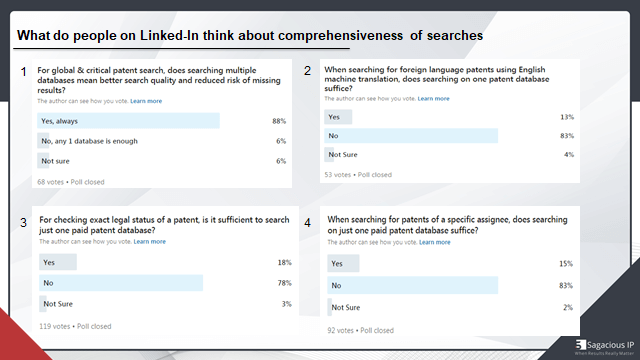
Polls’ Questions
Rohit: So, from the poll, on the first question, that is, for global and critical patent search factor. Search in multiple databases means better search quality and reduced risk of missing results. As you can see, 88% voters supported use of multiple searching databases.
On the second question as well, that is when searching for foreign language patent, using English machine translation, does searching one patent database suffice? We can see that 83% of users say that more than one patent database is required, which is quite interesting.
Onto the third question, for checking exact legal status of a patent, is it sufficient to search only one paid database and you can see 78% of people said that for checking exact legal status of a patent, one paid database is not sufficient.
And our last question is even for searching patents of a specific assignee, 83% of people said that one paid database is not enough.
So, these are the polls because of which we have planned this webinar for you. They wanted to put forward what we think on this question of one versus multiple databases. Now, let us move forward and see what we have done.
Thus, we have created few checkpoints that will help you understand our observation on the poll questions, and will help you decide one database or multiple databases for any kind of search.
Hence, there are four checkpoints. These are geographical coverage, non-English language coverage, assignee corporate tree and legal status.
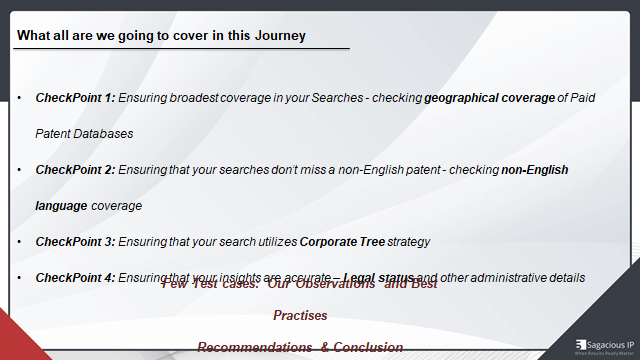
Checkpoints for databases
Checkpoint 1 is about worldwide coverage. Through this, we are here to ensure that how can you cover the broader coverage while searching. It will be telling how many countries actually get covered by various available paid databases, in short, the coverage of different paid databases.
On checkpoint 2, that is on non-English language coverage, we are here to ensure that your search don’t miss any non-English patent. Here, we will see how efficiently these databases cover non-English patent. In this we will be looking at the various language keywords covered by these databases.
Moving on to the checkpoint 3, that is assignee corporate tree. We want to ensure that how you can utilize the assignee corporate tree. We will check how assignee corporate tree can help us decide one or more patent databases for an assignee search.
And moving on to our last checkpoint, that is Legal status accuracy and other administrative details. We’re here to ensure that how and from where you can get the most updated legal status. We will share what is our observation on relying on legal status on the paid databases.
Finally, these are our checkpoints, we will discuss which database works better for which type of patent search. So, it is going to be an interesting session. But before I move forward, I would like to read out the disclaimer.
Disclaimer
- This study does not intend to endorse or defame any of the professional patent database discussed in this webinar.
- The information used in this webinar about the various patent databases is obtained from the respective official website.
- Sagacious IP does not own any of the logos or trademark used here. These are just for illustration purpose and we disown any claim.
- We do not own any data shown in this webinar, and all the data is collected from official websites, Patent databases and Worldwide web.
- The results, numbers and counts shown today are based on research done on 21st August, 2020.
So, moving on to the next slide.
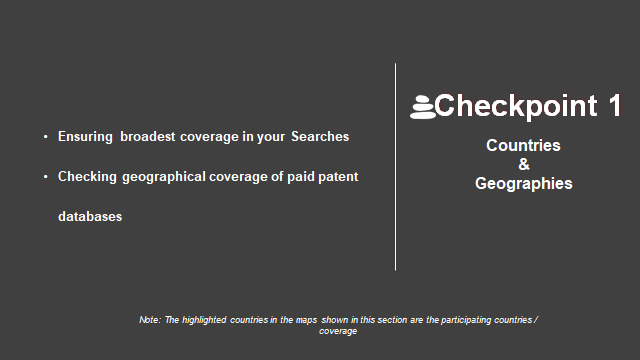
Checkpoint 1:Geographical Coverage
Let’s start with our first checkpoint. In the first checkpoint we will be seeing how to get maximum coverage in your searches and we will also check geographical coverage of the paid patent databases.
Comparison of Paris Convention Treaty and Patent Cooperation Treaty
So, if I talk about coverage, then I think the first question is: how many countries are there in this world? So, there are total 197 countries. And there are two major intellectual property treaties are, Paris Convention Treaty and Patent Cooperation Treaty.
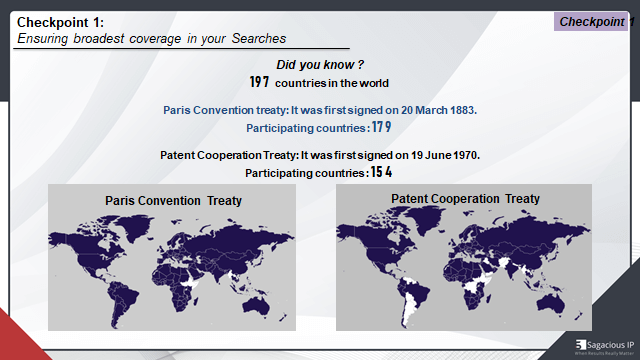
Who cover more countries Paris Convention Treaty or Patent Cooperation Treaty?
So, the Paris Convention Treaty was one of the first intellectual property treaties. It established as the Union for the protection of industrial property rights and it was signed in Paris, France on 20th March, 1883, and it includes 179 countries.
If I talk about Patent Cooperation Treaty, it was signed on 19th June, 1970 and there are total 154 countries in it. We have shown both these treaties on the world map. We can see that Paris Convention has more participating countries than PCT. Paris Convention cover almost whole world, leaving some of the African countries, and some of other countries.
And then we see the PCT which is the most preferred route through the globe while filing a patent. It has more countries that are not part of list. We can see even some of the South American countries are also not a member of PCT.
Overall, both the treaties cover almost the entire globe and patents are being filed in all these countries. Not just patent filings but these patents serve as the prior art and need to be searched in our patents searches in full text.
Now, let us do the real check and see how many countries’ available databases are able to actually search and show us patents.
Comparison of Paris Convention Treaty and PCT with Questel Orbit
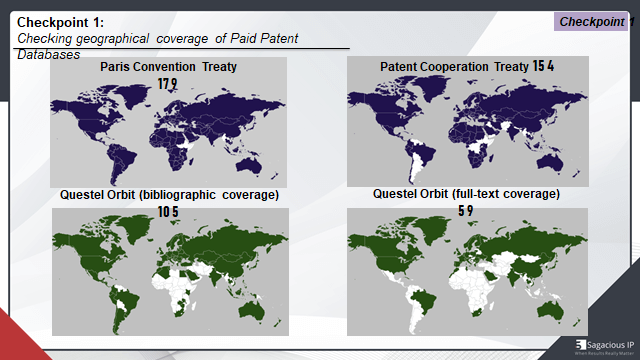
So, on the slide, we can see Paris Convention and Patent cooperation Treaty on the top left and right and on bottom left and right countries covered by Questel Orbit in general and Questel Orbit in full-text coverage.
The Questel Orbit database claims that they cover the bibliographic details of patents published in 105 countries. It includes the ARIPO, WIPO and EP patents as well.
When we talk about the full text coverage, they cover 59 countries, including WIPO, EP and African Organization. So, by full-text coverage, I mean title, abstract, claims, description, and all the bibliographic details.
The important point here is claims and description. By the bibliographic details, I mean title, abstract, assignee, inventor, publication date, etc., but excluding claims and description.
Point to note here is how this coverage is going to impact our search and how many results from these countries in which full text is not available we are going to miss while conducting research on these databases. So, we will discuss this in our coming slide and observation section.
So, let’s move to the next slide.
Comparison of Paris Convention Treaty and PCT with PatSeer
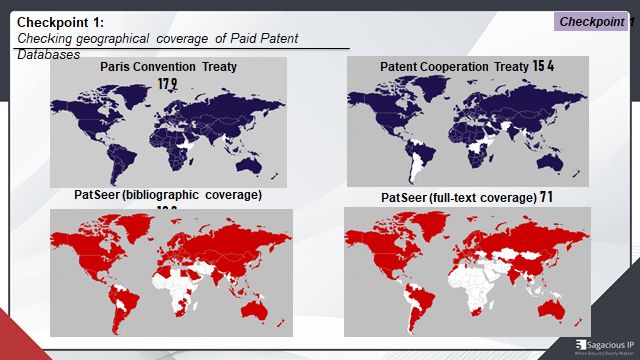
So, on this slide, we can see a comparison between Paris Convention and PCT countries versus PatSeer database coverage. PatSeer claims that they cover 103 countries including ARIPO, WIPO, and EP patents. But when we talk about their full text coverage they claim that they cover patents published in 71 jurisdictions, including EP, WIPO and African countries.
Comparison of Paris Convention Treaty and PCT with Derwent
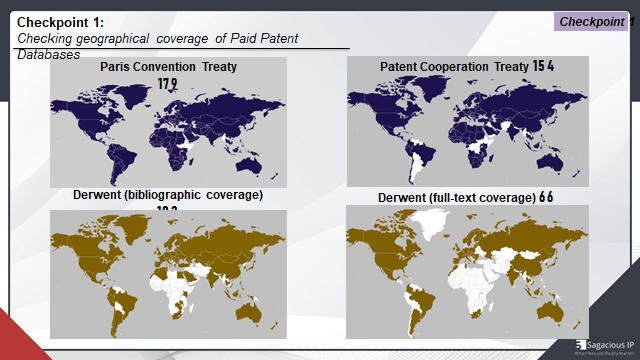
Moving on to the next slide, here we can compare coverage of Derwent innovation. Derwent claims that they cover bibliographic details of 1 or 2 countries including ARIPO, WIPO, and EP. And when we talk about their full text coverage, they claim that they cover full text of patents published in 66 countries.
Comparison of Paris Convention Treaty and PCT with PatBase
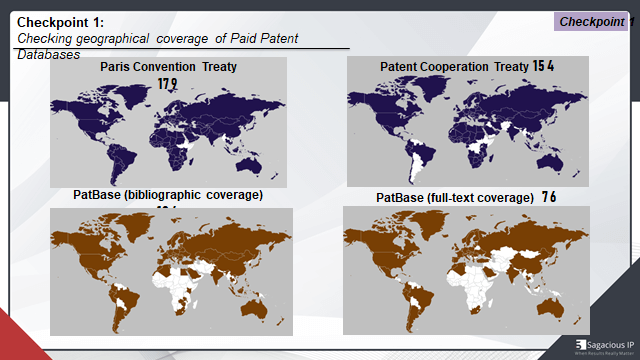
Another database is PatBase and PatBase covers bibliographic details of patent published in 106 countries including ARIPO, EP and WIPO. And when we talk about the full text coverage they cover patents published in 76 countries.
Summary and Insights
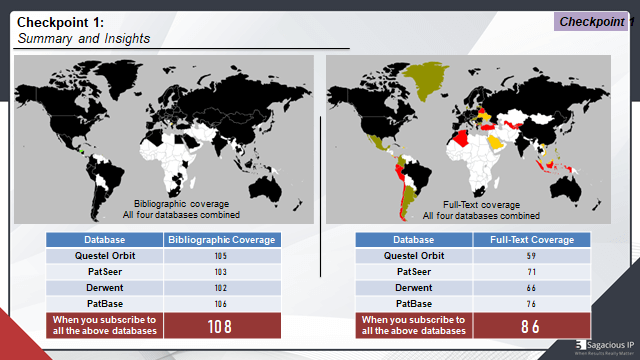
So, moving on to the next slide. Here, we have given you a brief of how many total countries actually gets covered. If you use all the databases then you can get the bibliographic details of 108 countries including WIPO, ARIPO and EP patents.
I understand that in terms of bibliographic coverage, the effect is not as much even if you use a single database. But what’s really important is that when we talk about the full text coverage, if you use all the databases there is a significant impact. As you can see in the table on the right side of the slide, using all the databases means you are covering 86 countries.
So, the black color in the map here shows the countries that are common to all the databases, and red, yellow and green color indicates the countries that are available in only 1 or 2 databases from the four databases that we have used for the observation.
The four databases are PatSeer, PatBase, Questel and Derwent. So, these are some of the unique countries that are not covered by all the databases. The countries that are highlighted in different colors, apart from black.
So, with these comparisons, we now have a fair idea of worldwide patent coverage by these databases. We will see in the last section how these coverages make a difference and impact our search.
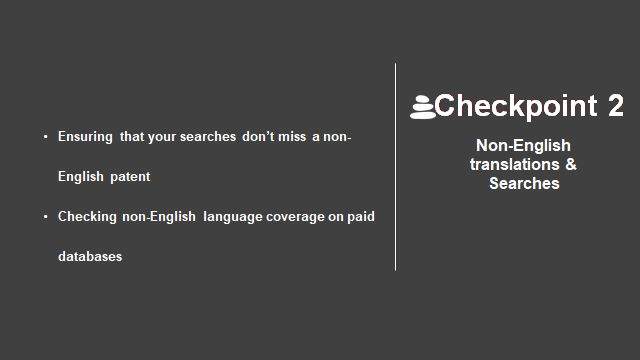
Checkpoint 2: Non-English Language Coverage
Now, moving onto the next checkpoint, that is a non-English translation and search. Here we are ensuring that your search doesn’t miss a non-English patent and we will be checking on non-English coverage of paid databases.
Languages in which patents are published
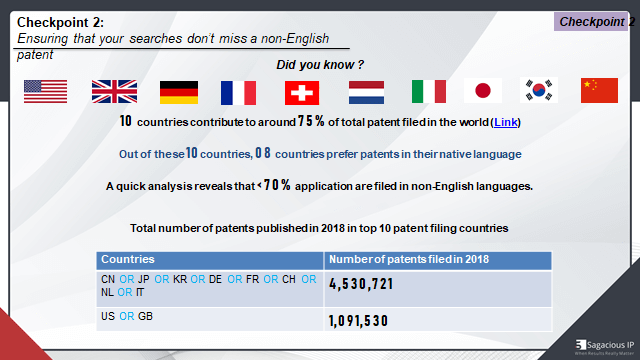
So, now, moving on to the next slide. Here at first step, we have checked the percentage for languages in which patents are published in 2018. So, what we have done here is, we have identified the top 10 patent filing countries in 2018.
So, these countries are US, China, Japan, Korea, Great Britain, Germany, France, Netherlands, Italy and Switzerland. Here, we have observed that out of these 10 countries 8 are filing patents in non-English languages.
Can we file a patent application in English language for a non-English country?
We have even checked that for some of the countries like Germany if an application is filed in English or French, you have to provide the certified German translation of an application file within 12 months from filing the application or within 15 months from the earliest priority date because the prosecution in Germany happened in German language, basically.
So, one interesting factor is that these top 10 countries contribute nearly 75% of the worldwide five patent application. So, also if we talk about non-English patent, you can see the numbers are surprisingly patent origin from non-English countries is more than 70%.
Since, we have these databases primarily in English, this again makes us pick a good machine translation tool to understand these non-English patents. All of these patent databases do provide us English translation. Now, that itself is questionable. The reason for this doubt is do machine translation is reliable enough.
Now, moving on to the next slide.
Translation of Text
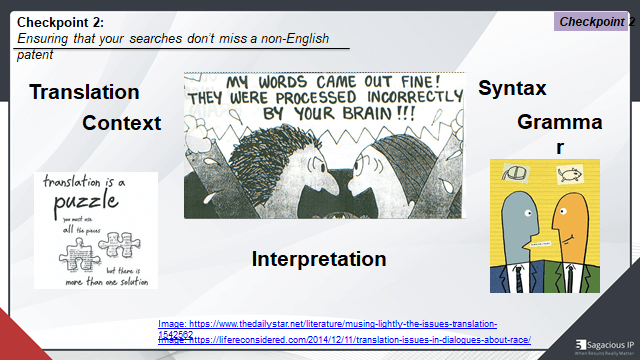
We are aware, translation is an art and so driver by experience. So, as you can see in these pictures, taken from the internet, translation is given a wrong direction can lead to mistakes.
Now the question is, whether our database translates non-English to English mechanically, or do they use some AI based intelligence to make it 100% accurate?
Similarly, if we talk about the term “interpretation”, we can see in the image that one person interpreted mouse as an animal and the other one as a device for a computer.
We understand that, this is an interesting topic to discuss in detail and we have an upcoming webinar specifically for this topic. So, please register on our website sagaciousresearch.com for more details.
Database coverage in native languages
Let us come back to the topic. Let us see if there’s doubt in mind to question further on translation. And, let us now focus on how much coverage these databases have in native languages.
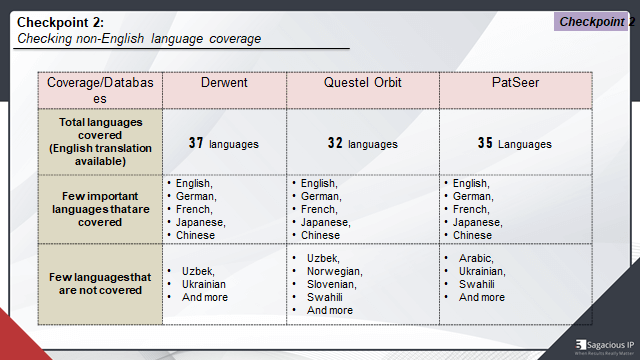
So, as per the official website of these databases, we got to know that, these database cover almost all the top countries, native languages, and native keywords.
Let us talk our analysis on language here with translation in doubt and native language original described as solution. I am calling it as solution here as we have something interesting that I will discuss with you in the last section of the webinar.
Further, all these databases cover all the major patent filing languages. But for some of the languages you have to rely on a specific database, for example, for Norwegian patent language, you have to rely on Derwent innovation, for Uzbek language patent, you have to rely on PatSeer and so on.
One interesting point is that these data also provide options for searching in native languages, for example, in PatBase you can search the patent in more than 10 languages.
Similarly in Orbit, you can search the patents in more than 6 languages. The patents will be obtained in native language, and if you are an expert on that language, you can analyze the patent specifically in that language.
Now, moving on to the next checkpoint.
Tanmay: Rohit, I guess both the checkpoints were quite interesting. And before we go to the next checkpoint, I would want to quickly ask our audience for a quick poll and I hope it should be visible to them now. So, the question that we want to understand here is that should we perform patentability searches on Google Patents?
We know that Google Patents is a very easy to use interface for searching prior art and patents. But I also back to defer that Google also records all the information. So, how do you weigh this? Do you feel like Google is a quick solution and the results that are given by Google are quite acceptable and you would want to go with Google or do you think that, no only professional paid databases that do not collect information and are secure should be the ones that are used specifically for patentability searches?
We will leave this poll open for another 30 seconds, so that our audience can participate and share their responses, and we will talk about these responses during the course of this webinar and, and discuss on how people think about it. So, yeah, another 10 seconds for that.
Once again, I would repeat the question: Should we perform patentability searches on Google Patents, the options are: No, Google collects all data, and my patentability searches are quite confidential, I don’t want to go to Google. The other option is, Yes, Google has good accuracy, and is easy to use. So, my R&D people, my teams find it quite convenient and they are quite adapted to it and they prefer searching on Google. So, another 10 seconds for the audience.
Great, we have the answers with us and I am now stopping the poll and passing the baton back to Rohit. Rohit, please continue with the checkpoint 3.
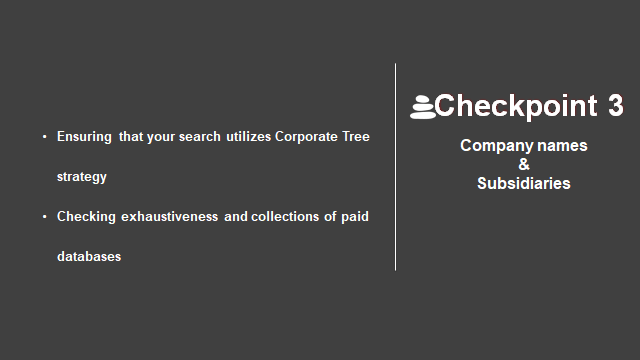
Checkpoint 3: Assignee Corporate Tree
Rohit: So, in this check point, that is, we have checked the company name and their subsidiaries. They are here to ensure that how you can utilize the assignee corporate tree in the best possible way.
So, here we are checking the exhaustiveness and a collection of paid databases in terms of assignees. So, almost all the databases create an assignee tree. This assignee tree is also called corporate tree and for those who do not know about it, it is the function provided by paid databases that allow you to see all the subsidiaries of a patent company and allow you to select companies of interest.
So, moving on to the next slide.
What corporate tree does?
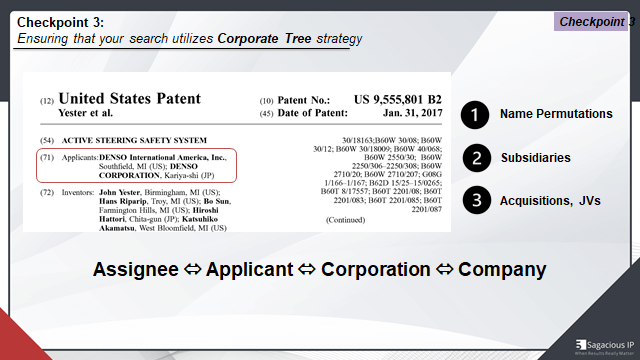
So, what corporate tree does? It ensure that you are covering the name, permutations, subsidiaries of a company, their acquisition and merger. We will explain this with the help of an example in the next slide.
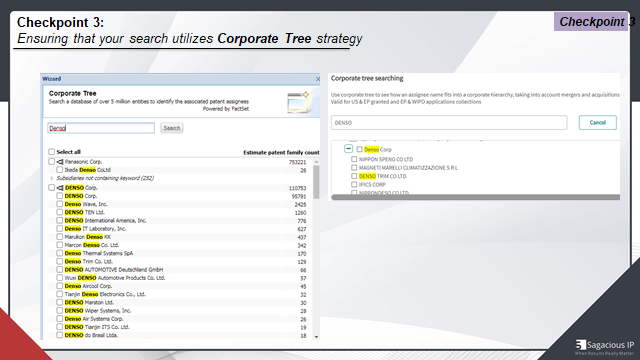
So, if you run Denso as assignee using the database corporate tree, you will find numerous subsidiaries like NIPPON SPENG, Nippondnso Co Limited, NIPON SPEND, IPICS CORP, etc.
This is the benefit that these paid databases provide. They call it almost all these subsidiaries for you, and you need not to look for subsidiaries in Google, until and unless there are specific client requirements.
If you don’t have this corporate tree , then you have to look for each subsidiary separately and it might be possible that sometimes you miss a lot of the subsidiaries, so these databases are helpful in that part.
Now, when you have these assignees correctly classified by these databases. The main advantage is that there are minimal chances that you miss any relevant patent of assignee or its subsidiary, specially, when you are looking for patent for any one corporate, all its subsidiaries.
Availability of corporate tree function
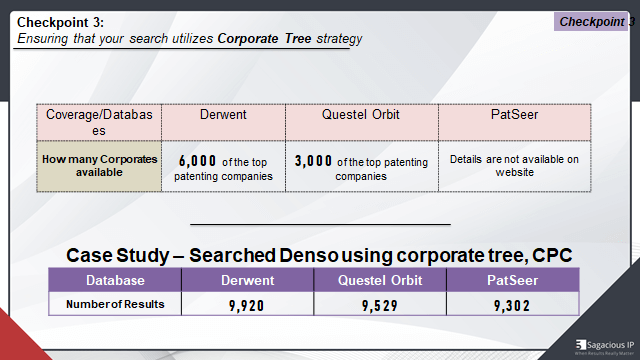
Now, moving on to the next slide, here in this slide, you can see that DerWent Innovations claim that they have the corporate tree function available for top 6000 patent filing assignees and they had new companies on yearly basis. This means that they have 6000 different buckets for different assignees and they keep updating these assignees for you.
So, you understand that they help us on assignee part, on assignee subsidiaries.
Similarly, Questel claims that they have corporate tree of top 3000 patent filing assignees.
PatSeer also has the corporate tree function. However, they do not disclose the number of assignees they have standaradized for us.
Here, we have one example for you. We have Denso’s corporate tree in three different databases. We have restricted our search strengths with F02M+ and the class is related to commercial engine.
Interestingly, here you can see that the number of patents captured by all the three databases are different. This means that as per these databases, Denso’s portfolio in this specific classification is different.
Now, let us keep this observation for our last section of this webinar and let’s move on to the next checkpoint, that is, legal status and docketing info. So, in this, we will ensure that your insights with respect to a patent are accurate.
Here, we will cover how to get the most updated legal status and administrative details of a patent and we will check accuracy of the databases while analyzing the legal status.
Checkpoint 4: Legal Status and Docketing Info
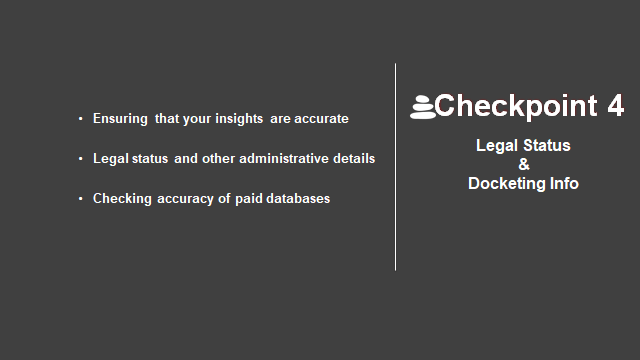
So, patent legal status or you can say that application status or you can say simply, Legal Status.
It is an essential piece of the patent information that helps industry professionals to know the status of the patent. By looking at this piece of information, they can instantly know if examination of a patent is still pending, if it was rejected or withdrawn, if a patent has been granted or is still valid, if granted patent has expired or renewed.
Accuracy of Paid Databases
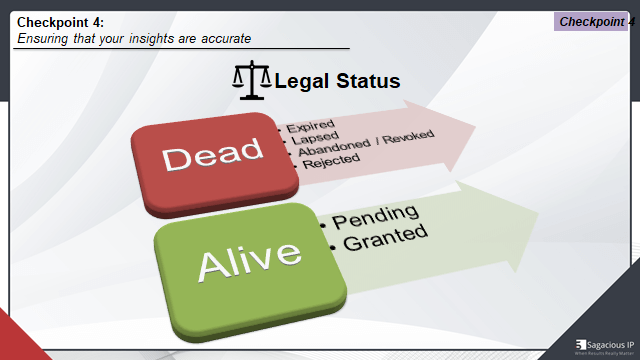
Now, moving on to the next slide. Here what we have done, we have checked the legal status accuracy of paid databases.
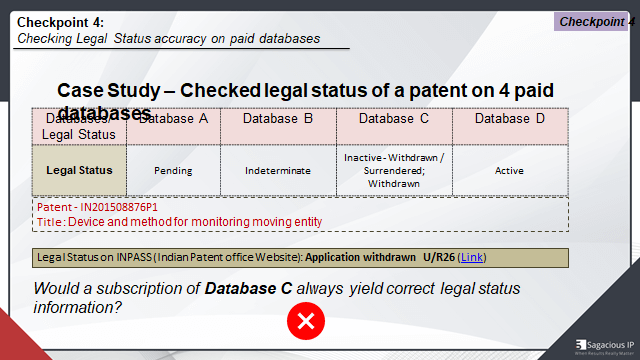
In this, we have checked the legal status of an Indian patent application, IN876P1. We observed that the legal status for this patent on Indian patent website is withdrawn. In database C also it is displayed as withdrawn. However, in Database A it is displayed as pending, in Database D, it is displayed as active while in database B, it is displayed as indeterminate.
For patent legal status, we refer National Patent Office website to get the latest version of legal status. You can see the discrepancies in all these databases, but it does not mean that all the databases are incorrect.
You can rely on other databases to some extent, only issue is that updation dates are different for all these databases and in critical matter, it is recommended not to take chances. For example, if you are launching your product in US, then you should check the legal status of USPTO, from USPTO, and similarly for European countries, you have to check the legal status on their respective patent website.
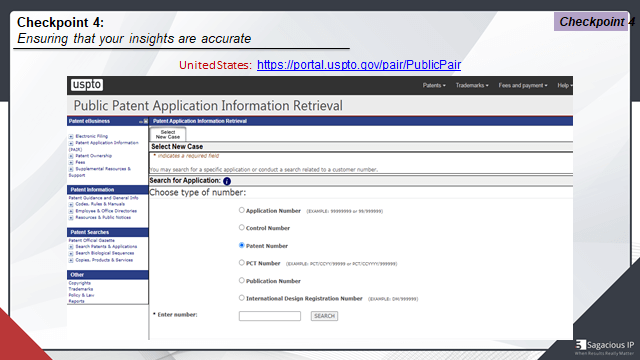
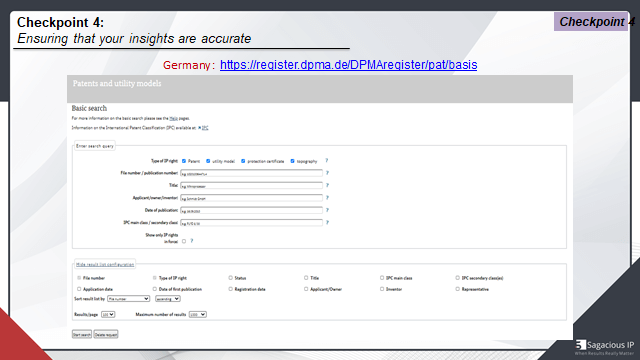
So, on slide 23 and 24, we have shared the link of USPTO and DPMA register to give you an idea about the interface of the two National Patent Office website. Thus, with this example, let us move to our final Conclusion and Observation section.
Hence, the question is? So the question is, is one database sufficient enough to execute all kinds of searches? Because of this question, we are conducting this webinar.
How all level checkpoints are crucial while conducting this search? How these check points impact your patent search?
So, we have discussed about the coverage of different databases, the languages covered by them, and the assignee corporate tree function, and the legal status, now we will discuss about the advantages and disadvantages of different databases.
So, what are the consequences if you perform search in a single database?
Tanmay: So, Rohit before we go ahead, I’m sorry, I’m interrupting you. The whole intent was that we just created a poll, and I promised our listeners that we will take a look at it before we go ahead to the final section. So, the poll question that we asked to our audience was, should we perform patentability search on Google patents. 67% of our listeners said that no, and 33% of our listeners, they said, yes, we should.
We would like to hear from you about should we use Google Patents or not? And if we do that, what should be our strategy, what kind of inventions can be used, or what kind of prior art searches can be done on Google patents without the risk of getting the data collected. So, what are your thoughts on that, Rohit?
Can we use Google Patents for patent search?
Rohit: So, as per my opinion, yes, you can do Google Search because you are not searching the specific innovation or specific novelty point. Whenever you do Google search, you just run broadly your search strings and you can quickly identify top results that Google provide, and you can analyze those results.
I recommend never to use your novelty point directly on Google search because it might be possible that your search, your stings might get recorded in some junk or you can say somewhere in the computer. So, it might be possible that if some other person see that invention, and he might claim your invention. So, from my point of view, you can do, but broadly.
Tanmay: So, do you recommend that, people working in in-house R&D functions, people who are working on secure systems or secure IT network, they can go ahead and search on Google Patents? Is that what you’re recommending?
Rohit: That they can do, but I still recommend not to search for a specific novelty. You can broadly search patents and you can analyze those patents manually.
Tanmay: Sure, Sure. Got it. Please go ahead with the last section. Thank you for answering that.
More Tests and Best Practices

Rohit: OK, so that the whole point of conducting this webinar is to answer whether one database is sufficient to execute all kinds of searches, how the above checkpoints are crucial while conducting a search, how this checkpoint impact your search.
So, above we’ve discussed about the coverages of different database, the language covered by them, the assignee corporate tree, legal status.
Now, we will discuss the advantages and disadvantages of different databases. What are the consequences if you use only one database, or what are the benefits or perks you are getting when you use multiple databases?
So, before we make a conclusion, let us take an example of our novelty search. For those who are new to patent searching, the aim of a requested novelty search is to search for possible obstacles to patenting.
What is Novelty Search and its example
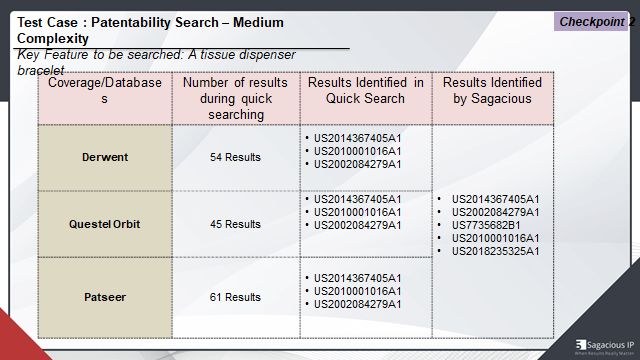
The novelty search will reveal publications, big technical solutions, that are similar to those disclosed in the request or closely resemble them.
Here, we have taken the example of novelty search that is related to a tissue dispenser bracelet. It is a bracelet from where napkin tissues are dispensed. We’ve already conducted this search internally, and in this search we have identified top five results and these are in the last column of the table, as you can see.
Here for testing, what we have done, we just used simple keywords on different databases. We have used bracelet and tissue toncets in title abstruct claims in all the paid databases.
And all these databases like this Questel Orbit, yields 45 results, Derwent Innovation yields 54 results, and PatSeer yields 61 results and all three databases are able to capture 3 of the 5 results that we had identified earlier after a regresel.
So, we can say that, since the novelty search is a low state project and if you’re a medium level searcher, you will be able to identify most of the documents by using multiple search strategies. Thus, we can conclude that, yes, you can use a single database for conducting a novelty search but you must have the knowledge about the different type of search strings or how to use different parameters that these database provide.
What is FTO search and its example
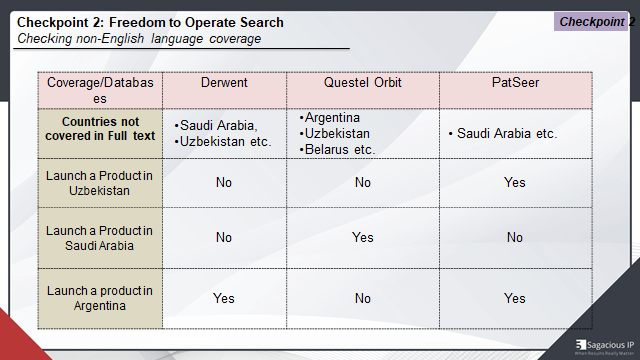
So, now moving on to the next slide. Here we are taking an example of an FTO search. Let me just give you a brief FTO. So, FTO is a Freedom to Operate Search. Thus, as its name suggests, you want to sell, or launch a product in a particular country, and you want freedom that no one will file a case or no one will infringe you.
Thus, what do you do? You look for all the alive patent applications in that country that your product might infringe. So, you conduct an FTO search to ensure that your product is not infringing any patent.
So, since all these databases are good and they cover the major jurisdictions, however, sometimes they do not have a full text coverage in a particular country then you have to check this database you should use to ensure the coverage.
Here, we have shown the countries that are not covered by some of the paid databases. For example, Derwent doesn’t cover Saudi Arabia, Uzbekistan in full text. Questel Orbit doesn’t cover Argentina, Uzbekistan and Belarus in full text, and there are many other countries, I’m just giving you some examples. Similarly, PatSeer doesn’t cover Saudi Arabia in full-text.
So, if you want to launch your product in Uzbekistan then you should go with PatSeer since it covers Uzbekistan’s patents in full text.
Similarly, if you want to launch a product in Saudi Arabia, you should go with Questel Orbit since it covers the Saudi Arabia in full text. Apart from that, you should also search on GCC official website to ensure that you’re not missing anything relevant. By GCC, I mean Gulf Cooperation council, they have a particular website for searching patents.
Again, if you want to launch his product in Argentina, then you should go either with Derwent or PatSeer since they cover Argentina in full text.
Now, moving on to the next slide.
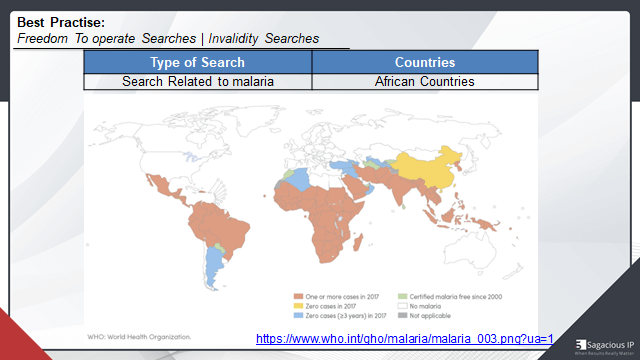
So, for invalidity searches and FTO searches, as mentioned earlier, the stakes are high. It is recommended that you should search on different databases to ensure that you are not missing anything relevant. Just to give you a brief of invalidity search, here, you have to invalidate the claims of the patent in question, there can be multiple reasons for it. Your product is infringing the patent, the patent owner is not willing to give you a license, etcetera, etcetera.
Now, I will elaborate it more by taking some examples. So, if you’re conducting a malaria related search, then you have to ensure that your database should cover African countries, since most of the patents filed there are related to malaria.
As you can see in the attached map, the African, Asian and some of the South American countries are miserably affected by malaria disease. Since most of the Asian countries and South American countries are covered by paid patent databases and to some extent, some African countries as well. However, it is recommended that if you conduct any invalidity or FTO search, you should also search on ARIPO patent website, if the search is specific to malaria.
Similarly, if you are doing any oil and gas related search, then you should ensure that your database should cover Gulf countries and majority of patents filed in Gulf countries are related to oil and gas. The same you can see in the attached chart.
Now, from this webinar till now, I am sure you must have decided whether to use one or multiple database for your searches. So, here in this slide, let me try to conclude various observations from checkpoints that we have discussed.
If you are searching only one database, then there’s a chance that you only search maximum of 76 countries, that is, if you have the subscription of that database. However, when you are using multiple databases, you can search around 86 countries but for that, you have the subscription of all databases.
In terms of bibliographic details, similar database is sufficient, as you can see the maximum coverage of all the databases is 108 a single database has maximum coverage of 107.
Similarly, if we talk about the language coverage. So, if you use all the databases, then it is nearly 40 languages that you are covering and, if we see the number of assignees standardize. If you use all the databases then you have around 6000 to 8000 standardized assignees. By using all the databases, you are ensuring that you’re not missing any relevant assignee. You must have seen in the earlier slide that the assignees in different databases provided different assignee numbers.
So, if you are using multiple databases then you are ensuring that you’re not missing any relevant assignees by using different assignees.
And for the last that is legal status, as mentioned earlier, for legal status, it is better to use the respective patent office website. However, you can use the legal status, from the paid databases. But as per our opinion, only for patentability searches because for those legal status, it is not that important. But for FTO and invalidity searches, it is recommended that you should check the official patent website for legal status.
Now, moving on to the next slide.
What should you follow while doing searches?
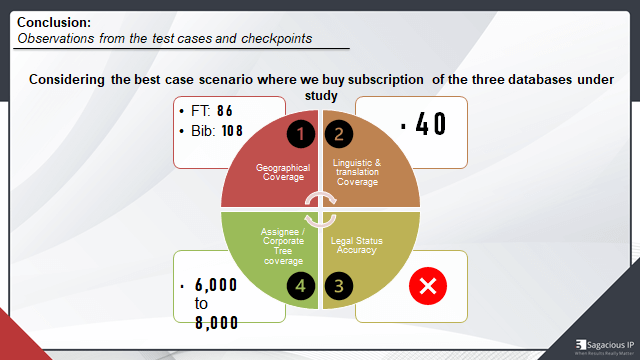
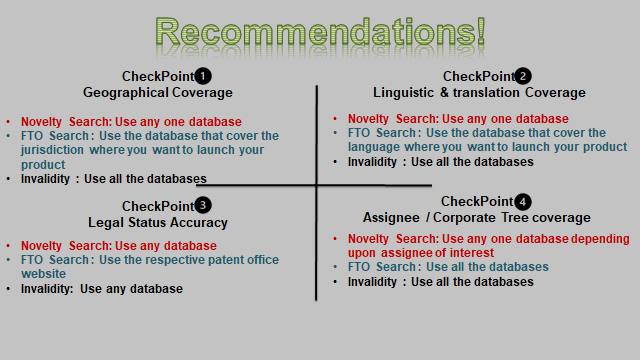
So, these are recommendations, and these are the things that we usually follow while doing searching. For novelty search, things are not very high and second is all the databases covered are most of the top patent filing countries.
So, for novelty search you can use any one database and you’re able to cover 90-95% of patents filed in top countries. Even for novelty searches, sometimes what happen, you will get the impotent of that patent.
So, let us say there is a patent that was filed in Saudi Arabia. Also, it is possible that, that patent is also valid in USA. So, all the databases have the coverage of USA, so, even if you use any one database that database is sufficient for conducting novelty searches.
Moving on to the next, that is FTO search. This is I’m talking about Geographical coverage. Thus, in FTO search, it is recommended to use the database that covered the jurisdiction where you want to launch a product.
As I already discussed earlier, if you want to launch a product in let’s say, Saudi Arabia then you have to look that paid database which have that coverage in full text, not just in bibliographic detail, because for active searches, the claims are really important.
Thus, you have to show that database should cover the patent in full text. Similarly, for invalidity cases, we recommend that you use all the databases since the stakes are really high in invalidity and FTO searches, so you should check all the databases for invalidity and FTO searches.
Linguistic and Translation Coverage
Now, on our second checkpoint, that is Linguistic and Translation Coverage. So, for novelty searches, again, use any one databases because 70% of the patents are already covered in the paid databases. But for FTO searches, use the database that cover the product where you want to launch your product.
Again, if you want to launch your product in some of the native countries, say Japan or China, so, it is recommended that you should also search the native language search in those countries, because sometimes English keywords or those native language keywords are not able to capture all the patents.
So, on the FTO or the states in FTO are really high, so, it is recommended you can use the paid databases where you want to launch the product and also, do the native language search. For invalidity, use all the databases.
Assignee / Corporate tree coverage
If we talk about third point, that is Assignee / Corporate tree coverage. So, for novelty searches, again, same recommendation, use any databases. For FTO search, use the respective patent office website because, as I already mentioned, for FTO search, the latest updated legal status is found on the respective Patent Office website, as I already explained this with an example of Indian Patent, where the four different databases show the four different legal status. So, it is better you should go for effective office patent website to ensure that you are not infringing anyone. And for invalidity, you can use any database or you can also go for their respective patent office website.
Now, if I talk about this assignee corporate tree. For Novelty searches, use any databases. For FTO searches, you can use all the databases because there might be there’s some subsidiary of assignee which you aren’t able to identify in one of the database. So, you have to ensure that you’ve checked all the databases. And if I talk about the invalidity, then use all the databases.
So that’s all from my side, Tanmay.
Tanmay: Thank you, thank you Rohit, for that great presentation. And yes, I believe that there is a little bit of type over here, so we will get that fixed. So, I believe that, if we want to summarize, then I think, we would want to say that subscribing to all the four databases can get you an inch of advantage, but not exactly a whole lot of advantage. It would totally depend on the use case that you have at hand. If you are going for a particular product launch in a specific country, then I guess you’ll have to select a database that has a full text coverage of that particular country.
However, I also believe that majority of the countries are, or majority of the active countries in the patent space are covered by most of the databases that are available and they would give you a fair idea about the prior art that is available there.
Also, as we mentioned, in the title of the webinar, and during that initial discussion that this webinar is totally focused on what should be an optimum strategy, should you just search on the paid database or should you search on paid plus free patent database to ensure comprehensiveness in your search?
So, I believe, from that standpoint, the question that we asked about Google Patents comes to relevance right now. So, almost there is a dearth of free patent databases as well. Google patents being one of them, then we have USPTO, then we have East Face neck and we have many others that are being commonly use and frequently used. One disadvantage that I believe I have felt using the free patent databases is, the structure.
Whenever we are using a paid database, we always have a structure at hand. We are able to do some classification search, their syntax, the kind of accuracy that these paid databases have, it has always amazed me.
However, with free patent databases, I have always used them as a backup, wherein I just wanted to quickly check the domain or get a quick understanding of what kind of prior art exist in that domain. But to do more specific and focused searches, I have always relied on a paid database. So far, in our webinar, we have just covered information about paid databases and talked to you about that.
For free patent databases, we would be hosting a separate webinar, wherein we would be comparing free patent databases, the way we did the paid databases, and then, sum up our opinion about, how can you optimize your strategy and, how a combination of paid plus free patent databases can result to an optimum search strategy for you.
Questions and Answers
With that, I would like to invite some questions from our audience, and also a quick note. We have an upcoming webinar on September 4th, and this webinar is focused on “How can you ensure accuracy while searching patents in machine translated text”. So, you can get more information about it by writing to us on our e-mail, and we will be happy to have you on board. So, one of the questions for you, Rohit, that I got is, does searching with non-English script really help, or have you ever tried it? Do you think it’s fruitful?
Does searching with non-English script really help, or have you ever tried it?
Rohit: So, thanks for asking this interesting question. So, in my opinion, yes, it helps us while searching and many times we also have got the results, specifically in invalidity cases for Japanese and Chinese patents. For identifying the Chinese and Japanese patents, this script really helps.
Tanmay: Got it. We have another question. If we want to search in a particular country, which is not covered by any of the paid databases that you mentioned, then what can we do?
What to do if above paid databases aren’t covered in a particular country?
Rohit: So, this is a really interesting question. So, audience want to know that country is not covered in any of the paid databases.
Tanmay: Yeah.
Rohit: So, first we need to look for the official patent office website of that particular country and if there is an official website then we have to search on that official website and if there is no official website and that country is not covered by any of the paid databases. In that case what we can do.First, we need to check whether we can file patent there or whether anybody can file there, and if yes, then we have to hire a local person there in that country and that person can check the patent for us on their patent library.
Tanmay: Got it. Got it. Then we have a floating question from one of our listeners, which database is maximum used? So, yeah, I think we would not be the right people to answer that, because a choice of a database is based on your business requirements.
Which database is maximum used?
The whole intent of this webinar was to give you a comparative landscape of what kind of coverages and what kind of languages and other things can you expect from a particular database. But we request all our listeners to kindly go ahead and take a trial of all the paid databases available, and see which databases suits them best according to their business needs and their operations. If you are in an oil and gas operation then, I guess, you would have to go for a database that has a full text, coverage of the Gulf countries.
If you are in medicines and drugs then probably, and specifically for drugs that are practiced in the African countries then probably you should go for a database that has coverage for that particular area. So, a neutral answer to this is that it totally depends on the business case and feel free to explore all the pay databases available, wherein you can get a particular coverage in terms of language, as well as geography.
One more interesting point that comes to my mind while speaking this is that, with free patent databases, you sometimes get a limitation about translations or probably about the scope or about the geographical coverage. With paid databases, you always have that assurity that if they’re mentioning about, or if they’re claiming that, they cover a particular geography, then it would be in entirety, you would be sure that you’re not missing any patent from that geography, and you would be sure that you are getting a good coverage over there. So, that is one thing that you can keep in mind.
Then we have another question about free patent databases, if we can talk a bit more about free patent databases? So, yeah, I mean, we can, but considering the time limit we have in front of us, I would request all our listeners who would want to know about free patent databases, to shoot us an e-mail and we have a comprehensive list of free patent databases available and we will be happy to respond and send you that list and also share some screen shots if it is required.
So, you can go ahead and start identifying prior arts over there. Happy searching to you.
So, if we have no more questions then, I guess we can end this webinar for now, and I would like to say that this has been a wonderful session. I’m sure our listeners have had great takeaways from this session, and will be able to use, several of the points, that we discussed while searching prior arts or making a strategic decision.
We have not been able to talk a lot about free patent databases. But please feel free to shoot us an e-mail and we would write back to you immediately showcasing our experience and talking about the free patent databases that we know of.
Also, I want to thank Rohit for the insightful sessions and to our listeners, I would want to say that if you want representation, or if you want the recording of this session, then you can e-mail us at [email protected], and we would be happy to send you the same. Also, a webinar alert for all our listeners today, we have an upcoming webinar on 4th September, which is specifically focused on ensuring accuracy while searching patents in machine translated text.
A lot of people who are planning to file applications in the Asian countries or in the European countries, which are non-English speaking and accept non-English patents, I think this would be a great webinar, and I welcome you all to attend it. Again, I want to extend a big thank you to all our listeners who helped us start on time and finish on time. We highly appreciate it, and we thank you very much. My best wishes to all of you. Stay safe, stay healthy and let us meet again in our next webinar.
Thank you. Bye, bye.
Submit Your Information to watch the Webinar Video:
"*" indicates required fields

